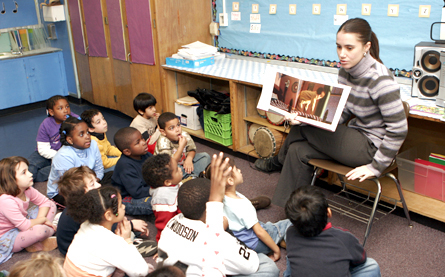
Mayor Michael Bloomberg and his Schools Chancellor Joel Klein have made sweeping changes in the city's schools, but the administration has ignored the number one concern of many parents, teachers and advocates: class size. A Newsday poll taken before the election found that class size remained the top education concern of voters. More recently, a Fordham online survey(in pdf format) of more than 500 parents and education advocates found that only 4 percent supported the mayor's education initiatives, while the overwhelming majority replied that his highest priority should be reducing class size.
This should come as no surprise. Smaller classes have repeatedly been shown to improve student achievement, cut down on teacher attrition, reduce disciplinary problems and increase parent involvement. While much of the focus on cutting class size has been on elementary grades, the overcrowded classrooms in many of our high schools have contributed to a state of perpetual crisis with rising drop out rates.
Today New York City’s classes remain the largest in the state by far. Though the Court of Appeals in the Campaign for Fiscal Equity case found that class sizes in New York City public schools were too large to provide children with their constitutional right to an adequate education, the mayor plans to spend only 2 percent of any money received as a result of the CFE suit to reduce class size. Instead, he intends to spend ten times as much on more administrators and specialists. On April 26, we will be in State Supreme Court to fight for the right of all New Yorkers to ensure that these funds are spent as the court intended.
This administration is undercutting the drive for smaller class size in six major ways.
1. FLOUTING STATE LAW
On March 16, State Comptroller Alan Hevesi, who has supported more state money for city schools, released his audit(in pdf format) of the city's use of over $500 million it has received from the state to cut class size since 1999. It found that as of last year, there were only 20 extra classes in kindergarten through third grade - not the 1,586 additional classes that education department officials claimed to have formed with state dollars. The comptroller also found that the city had sharply cut back the number of classes provided in grades K to 3 by almost 900 over the last four years.
If the Department of Education had actually formed the classes for which they had received state funding, the average class in the early grades would have 19.1 students. Instead, , despite declining enrollment, 65 percent of children in these grades remain in classes with 21 students or more, and 26 percent are in classes of 25 students or more.
 The comptroller concluded that the city was illegally charging the state for teachers who should have been paid for by the city.
The comptroller concluded that the city was illegally charging the state for teachers who should have been paid for by the city.
Though the findings of the audit were completed in July, its release was delayed for many months until the city provided a formal response. In a reply, dated November 7, 2005, the day before the mayoral election, Kathleen Grimm, deputy chancellor of finance and administration disputed the audit's methodology and conclusions, calling them overly "quantitative" and said the department would not change its practices.
While the state comptroller found there were schools with little room to form additional classes, he also found many that had the capacity, but had not received funds to add new classes or were not using the money appropriately. Moreover, there were elementary schools sitting only a few blocks away from each other, one overcrowded and with large class sizes, the other with plenty of room. But Grimm said there was no reason to change school boundary lines to address this.
2. TRYING TO KEEP THE VOTERS FROM DECIDING
Last year over 100,000 New Yorkers signed petitionsto put an amendment on the ballot that would require a minimum of 25 percent of the funds owed our schools as a result of the Campaign for Fiscal Equity case be spent on reducing class size to the levels elsewhere in the state, where classes are 10 to 60 percent smaller. This would allow voters to decide whether smaller classes should be required by law. But the administration has decided that this proposal is "improper" and should never appear on the ballot.
Why? The city makes the curious argument that the Department of Education is officially a state entity, and thus New York City voters can have no say when it comes to our public schools.
Taking this argument even further, the administration claims that Chancellor Joel Klein derives his authority over schools directly from the state, and thus no city law has any power over his actions. So the Department of Education refuses to comply with the anti-gay bullying lawpassed by the City Council or with regulations that require city agencies to use recycled paper.
In a recent case in which a parent sued the city for a slashing her child received at Evander Childs High School, the corporation counsel contended the city was not legally responsible, since the Department of Education was still under state control. The judge rejectedthe argument: "The Department of Education is a mayoral agency, just as are all the other city departments.” The city has appealed the decision.
Our coalition, New Yorkers for Smaller Classes, is contesting the administration's attempt to keep the charter amendment for smaller classes off the ballot. We are arguing that the chancellor and the Department of Education cannot be exempt from city law. A hearingis scheduled for April 26 in State Supreme Court.
Among the organizations submitting amicus briefs in support of the right of city voters to have a voice on this question are Citizen's Union (whose sister organization, Citizens Union Foundation, publishes Gotham Gazette), the NAACP, the Alliance for Quality Education, the Chancellor's Parent Advisory Council, and many other parent groups. Councilmember Robert Jackson and the Hispanic Federation are also intervening in support of our position and will be represented in court by Randy Mastro, former deputy mayor and head of a Charter Revision Commission under Giuliani.
3. CREATING FEWER NEW CLASSROOM SEATS
The following is the School Construction Authority's record of new seats created over the past four years, according to the Mayor's Management Report:
Fiscal year 2003 -- 22,267
2004 -- 12,921
2005 -- 8,631
2006 -- 4,287
There are fewer each year. (For a visual, see Class Size Matters.)
How many new seats were formed in the first four months of this fiscal year? Only 204. We are in danger of creating more seats in new stadiums than in schools during this administration.
And yet neighborhoods in all the five boroughs are experiencing a development boom, and it is now predictedthat the city's population will expand to more than nine million people by 2020.
In communities from Staten Island to the Bronx, large-scale housing and mixed-use projects are springing up - with no provision for all the additional students who will live in them.
In his State of the City speech, the Mayor bragged about the massive new developments, and boasted of a "sweeping inter-agency, five-borough Strategic Land Use plan that examines all of our city's neighborhoods and their needs for the 21st century, focusing particularly on housing, transportation, energy, and infrastructure – including parks." He made no mention of schools, the most chronically under-funded aspect of our infrastructure.
 Many of these projects would never be built without large tax breaks to the developers. We are about to give the Mets nearly $300 million in subsidies and tax exemptions, according to the Independent Budget Office, without asking that a single school be included in the project -- this in a neighborhood with some of the most overcrowded schools in the city.
Many of these projects would never be built without large tax breaks to the developers. We are about to give the Mets nearly $300 million in subsidies and tax exemptions, according to the Independent Budget Office, without asking that a single school be included in the project -- this in a neighborhood with some of the most overcrowded schools in the city.
But in other cities, developers of projects have to provide schools and other community projects. In school districts from Texas to California, developers are obligated to pay impact fees, to ensure that sufficient school space is provided to accommodate any increase in school enrollment because of their projects. In Miami, 20,000 new school seats have been created this year, with another 20,000 planned for next, in part by placing schools in new office buildings. This has enabled Superintendent Rudy Crew, who formerly headed the New York City system, to reduce class size in all grades. Unfortunately, in New York City, education is the forgotten stepchild of economic development.
Now that the city is expected to receive more than $9.2 billion for school facilities over the next five years, the capital plan needs to be amended so that it does what this specific figure was calculated by the court to achieve -- provide enough space to reduce class sizes in all grades through 12. In the current capital plan, the administration spends only one third of these funds on new capacity, with more money devoted to "restructuring" schools than building new ones.
The City Council should hold hearings to explore whether we can harness the development boom to our advantage, or whether our elected officials will stand on the sidelines as schools become even more overcrowded and another generation of students is doomed to failure.
4. THE MAYOR BREAKING HIS PROMISES FOR GOVERNORS ISLAND
When Michael Bloomberg first ran for mayor in 2001, he pledged to put high schools on Governors Island.
"We should build a major high school and university complex on Governors Island in partnership with one or more of our great private universities, he said on October 17, 2001. "The room is there for athletic facilities, laboratories, workshops, classrooms, etc. This would also free up many existing buildings in all boroughs for junior high school, elementary school and special education uses. "
Almost five years later, according to the mayor’s office, the city and state are “working on a plan to develop educational facilities on the site.” But no one in the administration seems to be talking about public school or CUNY classrooms on the island anymore. Instead, the Governors Island Preservation and Education Corporation, a joint city/state corporation, has been told to maximize the island's profit-making potential.
The facilities on Governors Island could have a significant impact on the city’s severely overcrowded high schools. According to the lease agreement, at least 20 acres of Governors Island have to be employed for education. Buildings that once held classrooms and would be perfect for high schools sit vacant, with sports fields adjacent, waiting to be used.
5. OPENING MORE CHARTER SCHOOLS
The mayor and his allies in the business world propose to create up to 100 new charter schools. Chancellor Klein has assured members of the City Council that he would not allow any new charter school to be created before it had an appropriate home. But the department's capital plancalls for 74 percent of them to be put in existing school buildings.
These actions will likely further overcrowd current public schools and raise their class sizes. Each new school gobbles up valuable classroom space for administrative and specialty purposes -- space that could be used to reduce class size instead. Already, a public school in Harlemand another on the lower East Side face the threat of larger classes as a result of the administration's intention to put charter schools into their buildings.
Of the 22 New York City public schools that currently share space with charter schools, only two did not see a significant increasein class size in at least one grade and usually many grades after a charter school was placed in its building.

The City Council ought to take the $100 million the mayor put into next year's budget for charter schools, and instead use it to improve outcomes for all our students, by reducing class size in our middle schools where test scores are flat or declining, and where children sit in classes of 28 or more.
6. INCREASING OUT-OF-CLASSROOM POSITIONS
There has been an explosion of out-of-classroom positions in our schools since the beginning of the Bloomberg administration. The headcount of bureaucrats at Tweed has mushroomed by 64 percent since 2003, only partly offset by a decline of administrators at the district level. Meanwhile, in 2005, the city comptroller found that there was a net loss of over 2,000 teachers in two years. "If dollars that are going directly to the classroom are not being invested in teachers, it begs the question: how was the money spent?" asked Comptroller William Thompson.
More recently, the Educational Priorities Panel (in pdf format) discovered that the percentage of spending devoted to instruction steadily declined during the first four years of the Bloomberg administration.
What are all of these people doing, what are they costing, and are they worth it? Would it be better to invest these funds on hiring more classroom teachers, so that class size could be reduced?
The City Council should take a serious look at these issues and take appropriate action to ensure that our children get the smaller classes they deserve.
Leonie Haimson is executive director of Class Size Matters. Â




